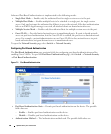
104 Update with your book title
•
Admin Speed
— The configured rate for the port. The port type determines what speed setting
options are available. Admin speed can only be designated when auto negotiation is disabled on the
configured port.
•
Current Port Speed
— The actual currently configured port speed (bps).
•
Admin Duplex
— The port duplex mode can be either
Full
or
Half
.
Full
indicates that the interface
supports transmission between the device and its link partner in both directions simultaneously.
Half
indicates that the interface supports transmission between the device and the client in only one
direction at a time.
•
Current Duplex Mode
— The currently configured port duplex mode.
•
Auto Negotiation
— Enables Auto Negotiation on the port. Auto Negotiation is a protocol between
two link partners that enables a port to advertise its transmission rate, duplex mode and flow control
abilities to its partner.
•
Current Auto Negotiation
— The currently configured Auto Negotiation setting.
•
Admin Advertisement
— The speed that the port advertises. Options include Maximum Capacity, 10
10 MB Full-Duplex, 100 MB Half-Duplex, 100 MB Full-Duplex and 1000 MB Full-Duplex.
•
Current Advertisement
— The port advertises its speed to its neighbor port to start the negotiation
process. The possible field values are those specified in the
Admin Advertisement
field.
•
Neighbor Advertisement
— Indicates the neighboring port’s advertisement settings. The field values
are identical to the Admin Advertisement field values.
•
Back Pressure
— Enables Back Pressure mode on the port. Back Pressure mode is used with Half
Duplex mode to disable ports from receiving messages.
•
Current Back Pressure
— The currently configured Back Pressure setting.
•
Flow Control
— Enables or disables flow control or enables the auto negotiation of flow control on the
port. Operates when port is in
Full
duplex mode.
•
Current Flow Control
— The currently configured Flow Control setting.
•
MDI/MDIX
— Allows the device to decipher between crossed and uncrossed cables.
Hubs and switches are deliberately wired opposite the way end stations are wired, so that when a hub or
switch is connected to an end station, a straight through Ethernet cable can be used, and the pairs are
match up properly. When two hubs/switches are connected to each other, or two end stations are
connected to each other, a crossover cable is used ensure that the correct pairs are connected. The
possible field values are:
–
Auto
— Used to automatically detect the cable type.
–
MDI (Media Dependent Interface)
— Used for end stations.
–
MDIX (Media Dependent Interface with Crossover)
— Used for hubs and switches.
•
Current MDI/MDIX
— The currently configured device MDI/MDIX settings.
•
LAG
— Specifies if the port is part of a LAG.


















